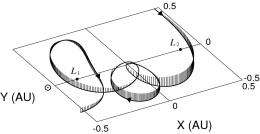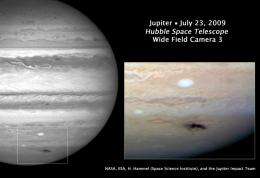Jupiter had temporary moon for 12 years

Comet 147P/Kushida-Muramatsu was captured as a temporary moon of Jupiter in the mid-20th century and remained trapped in an irregular orbit for about twelve years.
There are only a handful of known comets where this phenomenon of temporary satellite capture has occurred and the capture duration in the case of Kushida-Muramatsu, which orbited Jupiter between 1949 and 1961, is the third longest. The discovery will be presented at the European Planetary Science Congress in Potsdam by Dr David Asher on Monday 14 September.
An international team led by Dr Katsuhito Ohtsuka modelled the trajectories of 18 “quasi-Hilda comets”, objects with the potential to go through a temporary satellite capture by Jupiter that results in them either leaving or joining the “Hilda” group of objects in the asteroid belt. Most of the cases of temporary capture were flybys, where the comets did not complete a full orbit. However, Dr Ohtsuka’s team used recent observations tracking Kushida-Muramatsu over nine years to calculate hundreds of possible orbital paths for the comet over the previous century. In all scenarios, Kushida-Muramatsu completed two full revolutions of Jupiter, making it only the fifth captured orbiter to be identified.
Dr Asher said, “Our results demonstrate some of the routes taken by cometary bodies through interplanetary space that can allow them either to enter or to escape situations where they are in orbit around the planet Jupiter.”

Asteroids and comets can sometimes be distorted or fragmented by tidal effects induced by the gravitational field of a capturing planet, or may even impact with the planet. The most famous victim of both these effects was comet D/1993 F2 (Shoemaker-Levy 9), which was torn apart on passing close to Jupiter and whose fragments then collided with that planet in 1994. Previous computational studies have shown that Shoemaker-Levy 9 may well have been a quasi-Hilda comet before its capture by Jupiter.
“Fortunately for us Jupiter, as the most massive planet with the greatest gravity, sucks objects towards it more readily than other planets and we expect to observe large impacts there more often than on Earth. Comet Kushida-Muramatsu has escaped from the giant planet and will avoid the fate of Shoemaker-Levy 9 for the foreseeable future”, said Dr Asher.
The object that impacted with Jupiter this July, causing the new dark spot discovered by Australian amateur astronomer Anthony Wesley, may also have been a member of this class, even if it did not suffer tidal disruption like Shoemaker-Levy.
“Our work has become very topical again with the discovery this July of an expanding debris plume, created by the dust from the colliding object, which is the evident signature of an impact. The results of our study suggest that impacts on Jupiter and temporary satellite capture events may happen more frequently than we previously expected,” said Dr Asher.
The team has also confirmed a future moon of Jupiter. Comet 111P/Helin-Roman-Crockett, which has already orbited Jupiter three times between 1967 and 1985, is due to complete six laps of the giant planet between 2068 and 2086.
Source: Europlanet



















